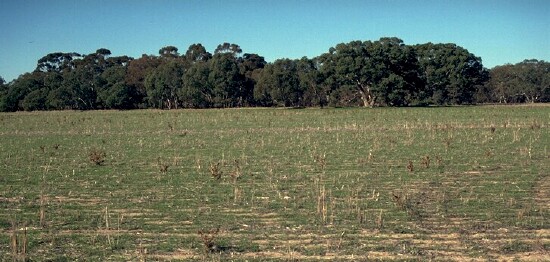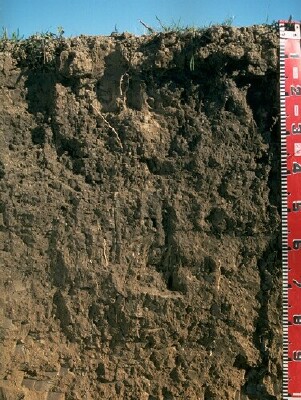LP67
| Group: Glenloth East Farm Advance Group | Australian Soil Classification: Vertic, Subnatric, Grey SODOSOL |
| Northcote Factual Key: Dy 2.13 | Great Soil Group: solodic soil |
| General Landscape Description: Active flood plain of Avoca River. Original vegetation included River Red Gum (Eucalyptus camaldulensis). | |
 LP67 Landscape |
Soil Profile Morphology
Surface Soil
| A11 | 0-10 cm | Greyish brown (10YR5/2); very heavy clay loam (fine sandy); hardsetting surface condition; moderate coarse blocky structure; firm consistence moist; pH 5.9; clear change to: |  LP67 Profile |
| A12 | 10-20 cm | Dark greyish brown (10YR4/2); heavy clay loam (fine sandy); moderate coarse subangular blocky structure; strong consistence dry; pH 6.1; clear change to: | |
| Subsoil | |||
| B21 | 20-50 cm | Dark greyish brown (10YR4/2); medium heavy clay; moderate coarse prismatic, breaking down to strong coarse blocky structure; firm consistence moist; some slickensides present; pH 7.9; gradual change to: | |
| B22 | 50-85 cm | Dark greyish brown (10YR4/2); heavy clay; strong coarse blocky structure; strong consistence moist; some slickensides present; pH 8.2; gradual change to: | |
| B23 | 85+ cm | Brown (10YR4/3); heavy clay; rigid consistence dry; contains a few (<2%) hard carbonate nodules (up to 5 mm diameter); some slickensides present; pH 8.7. | |
Key Profile Features
- Texture contrast between surface (A) horizons and subsoil (B) horizon.
- Sodic and dispersive subsoil with vertic properties.
Key Profile Characteristics
pH | Salinity Rating | |||
Surface (A1 horizon) | moderately acid | low | non-sodic | none1 |
Subsoil (B21 horizon) | slightly alkaline | very low | sodic | strong |
Deeper subsoil (at 85+ cm) | strongly alkaline | low | sodic | strong |
| 1 Moderate dispersion after remoulding. | ||||
 |
Management Considerations:
Wole Profile:
- Plant available water capacity (PAWC) is considered to be moderate (estimated at approximately 120 mm) for this soil profile. This is based on available laboratory data and assumes an effective rooting depth of 80 cm. Effective rooting depth will be restricted by the deeper sodic subsoil.
Surface (A) Horizons
- Organic carbon and total nitrogen levels are quite reasonable for this site. Organic matter levels will have improved with the adoption of direct drilling practices. Organic matter is important for maintaining aggregate stability on surface soils such as these with high fine sand (24%) and silt (35%) contents. Practices such as minimum tillage, stubble retention and pasture rotation should be encouraged. If organic matter levels are low the soil is more prone to structural degradation (e.g. compaction, cloddiness). Organic matter will also improve water holding capacity and fertility of the soil, as well as improving water and air movement.
- The surface soil is non-sodic but will disperse moderately after remoulding. Over-stocking or excessive cultivation of the soil when wet may result in surface sealing and exacerbate the hardsetting condition.
- The subsurface (A12) horizon is sodic and disperses moderately to strongly in water. When remoulded, however, it disperses strongly. This indicates that structural degradation could occur if this horizon is cultivated in a wet condition. It may then set hard and become dense on drying (and could develop into a plough pan). The addition of gypsum to this horizon may assist in improving the physical condition of the soil.
Subsoil (B) Horizons
- The subsoil is sodic and has a low calcium:magnesium ratio (ie. <1). It displays slight to moderate dispersion in water. This will result in restricted root and water movement through the subsoil. The addition of gypsum and deep tillage has been advocated as a soil ameliorative technique for some soils with sodic subsoils (Jayawardane and Chan 1994). A test strip in the paddock could be used to assess the benefits of this technique.
- The subsoil exhibits vertic properties (ie. slickensides, deep cracking) which indicates that significant shrinking and swelling occurs on wetting and drying. This can disrupt roots of perennial species and will have implications for engineering applications (e.g. foundations for buildings).
Comments from Landholder
- Never cultivated until 30 years ago.
- Wheat cropped in 1993. Clover grown before that.
- Gypsum has not been used recently.
- Prior to direct drilling being practised, the surface aggregates dispersed strongly.


